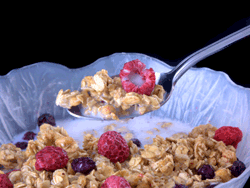

| Nutrient Claim | means… |
|---|---|
| Calorie free | less than 5 calories per serving |
| Low calorie | 40 calories or less per serving |
| Fat free | Less than 0.5 grams of fat per serving |
| Low fat | 3 grams or less of total fat |
| Low saturated fat | 1 gram or less saturated fat per serving |
| Saturated fat free |
Less than 0.5 g of saturated fat
perserving and the amount of
trans fatty acids does not exceed 1% of the total fat
|
|
Reduced fat Less fat |
At least 25% less fat than the regular version |
| Sugar free | Less than 0.5 g of sugar per serving |
| Reduced sugar |
At least 25% less sugar per serving than
the regular version
|
| High fiber | 5g or more fiber per serving |
| Good source of fiber | 2.5 g to 4.9 g of fiber per serving |
| Cholesterol free | Less than 2 mg per serving |
| Low cholesterol | 20 mg or less per serving |
|
Reduced cholesterol Less cholesterol |
At least 25% less cholesterol per serving
than the regular version
|
|
Sodium free Salt free |
Less than 5 mg of sodium per serving |
| Low sodium | 140 mg of sodium or less |
|
Reduced sodium Less sodium |
At least 25% less sodium per serving
than the regular version
|
|
Good Source of… Contains… Provides… |
these terms mean that one serving of
a food contains 10-19% of the Daily Value
|
|
Excellent Source of… High in… Rich in… |
these terms mean that one serving of a food
contains 20% or more of the Daily Value
|
|
Lean Meat, poultry, seafood and game meat with less than 10 g fat, 4 g saturated fat, and 95 mg cholesterol per serving. |
|
|
Extra lean Meat, poultry, seafood and game meat with less than 5 g fat, 2 g saturated fat, and 95 mg cholesterol per serving. |
|
|
Lite or Light This can mean two things. The product can have 50% less fat than the higher fat version or the product contains 1/3 fewer calories. For example Dreyer’s vanilla ice cream contains 150 calories per ½ cup serving and 10 grams of fat. The Dreyer’s light ice cream contains 100 calories per ½ cup serving and 3.5 grams of fat. The term “light” can also refer to the texture and color as long as the label explains it. For example, “light brown sugar” or “light olive oil.” |
|
|
Reduced in… |
|
designed to be flexible enough to change with new scientific understanding as needed. By knowing the definition of these terms used by food manufacturers, you will have the tools to be able to make wise choices for you and your family.

0 Comments